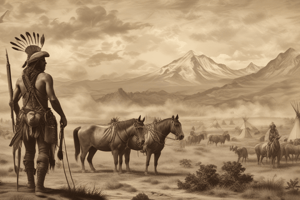Podcast
Questions and Answers
What period in U.S. history is referred to as Westward Expansion?
What period in U.S. history is referred to as Westward Expansion?
- Late 1700s to early 1900s (correct)
- Early 1500s to late 1600s
- Early 1900s to mid 2000s
- Mid 1800s to early 2000s
What was the primary reason behind the Louisiana Purchase in 1803?
What was the primary reason behind the Louisiana Purchase in 1803?
- To discover new resources
- To resolve conflicts with Native American tribes
- To reduce the size of the U.S.
- To expand the U.S. territory (correct)
What event in 1848 further fueled westward expansion?
What event in 1848 further fueled westward expansion?
- The Mexican-American War
- The discovery of gold in California (correct)
- The creation of the Pony Express
- The establishment of the Oregon Trail
What was the outcome of the conflicts between the U.S. and Native American tribes during westward expansion?
What was the outcome of the conflicts between the U.S. and Native American tribes during westward expansion?
Which Native American tribe was forcibly removed from their ancestral lands in the 1870s?
Which Native American tribe was forcibly removed from their ancestral lands in the 1870s?
What was the impact of westward expansion on the United States?
What was the impact of westward expansion on the United States?
Study Notes
Westward Expansion in U.S. History
Introduction
Westward expansion refers to the period from the late 1700s to the early 1900s when the United States expanded its territory from the original 13 colonies to encompass much of the present-day continental United States. This expansion was driven by a variety of factors, including the desire for new resources, the belief in Manifest Destiny (the belief that Americans were destined to expand their country), and the need to resolve conflicts with Native American tribes.
Factors Driving Westward Expansion
The U.S. began to expand westward as early as the 1800s. The Louisiana Purchase in 1803 doubled the size of the United States, and the acquisition of new territories continued throughout the 19th century. The discovery of gold in California in 1848 further fueled westward expansion, as people flocked to the newly acquired territories in search of wealth.
Native American Conflicts
As the U.S. expanded westward, it encountered Native American tribes who had been living in the region for hundreds of years. Conflicts between the two groups were common, and many Native American tribes were forced to relocate or face violent conflict. One notable example is the Nez Perce tribe, whose members were forcibly removed from their ancestral lands in the 1870s.
Impact of Westward Expansion
Westward expansion had a profound impact on the United States. It led to the expansion of the country's territories and the establishment of new states such as California, Oregon, and Washington. However, it also resulted in the displacement and violence against Native American tribes.
Conclusion
Westward expansion was a significant period in U.S. history, during which the country expanded its territory and established new states and territories. However, it also led to conflict with Native American tribes and the displacement of many Native American communities. Understanding the complexities of westward expansion is essential for understanding the development of the United States as a nation.
Studying That Suits You
Use AI to generate personalized quizzes and flashcards to suit your learning preferences.
Description
Test your knowledge on the westward expansion period in U.S. history, from the factors driving expansion to the conflicts with Native American tribes and the overall impact on the country. Explore questions related to Manifest Destiny, Louisiana Purchase, Native American displacement, and new state establishments.




